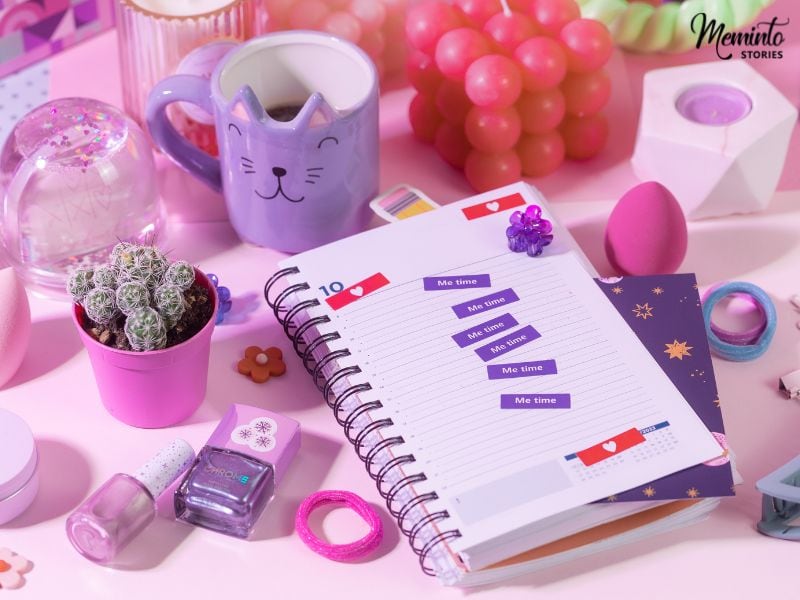The best DIY bullet journal ideas include emotions journal, future goals journal, daily reflections journal, mind map journaling, vision board, gratitude journal, affirmation journal, dream journal, fitness journal, and audio or video journal. It’s time to bring to life your creativity and be inspired to explore these DIY journal ideas.
Whether you are experienced in writing journals or you are literally just planning to start, we believe that you should be looking for new and exciting ideas to give you some sort of inspiration to start journaling and even add a flair to your style of journaling. To help you get started, we will share some journaling ideas to give you new techniques, making it easier for you to better understand yourself and your environment.
In this article, we will give you 20 DIY journal ideas for inspiration and guidance to help you get started with journaling or continue journaling in 2025.
Key Takeaways
- DIY life journal ideas include emotions journal, future goals journal, daily reflections journal, mind map journaling, vision board, gratitude journal, affirmation journal, dream journal, fitness journal, and audio or video journal.
- Journaling can be customized to fit personal preferences and needs, making it a versatile tool for self-reflection, personal growth, and creativity.
- The use of digital tools and apps like Meminto can enhance the journaling experience, providing features like transcription, photo integration, and ease of access.
20 DIY Bullet Journal Ideas

1. Emotions Journal
An emotional journal lets you decipher and understand all your emotions. With the main focus on your feelings, you get insight into how they are affecting your life and how you can cope with or deal with those aspects. It is equally difficult talking about feelings since it will make you feel uncomfortable or vulnerable while doing so. There isn’t a rigid way to explore feelings in journals. The key is finding the method and format that work best for you and that you will stick with.
One approach is to pen down your emotions as they arise. Describe what triggers them, how they make you feel in your body, and how you react to them. It may make you realize certain patterns and have a better understanding of your emotional reactions.
Another way is to give each emotion a specific name. You may be surprised to learn that it has more than 271 names for how we feel. Naming your feelings makes it concrete and much easier to handle.
Prompts can also bring your writing on track. Such questions as “What am I feeling right now?” or “How did this situation make me feel?” will help to focus on certain feelings and situations. At the same time, emotional journaling can be free within a broader mindfulness practice. Just record your thoughts and feelings when they come into your consciousness; observe them with interest but without judgment.
2. Future Goals Journal
A journal of future goals is a great way for reviewing hopes, goals, and plans. By thinking ahead and making plans now, you will be able to take charge of your life, not just deal with the events that come your way. Future planning keeps you on point with thinking about how you will obtain your goals, keeps you feeling less useless, and it prepares you for unforeseen situations.
One of the ideas is to write about all that you wish for. Think about what you hope to achieve and express these thoughts in writing. It serves as an exercise towards making your dreams clear and concrete.
Another choice is to ask the question, Where do you envision yourself in the future: 5, 10, 20? Try to see as best as is possible what the details of your life look like at those points in the future. These could be personal, professional, or lifestyle aspirations.
Finally, consider how you can turn your hopes and dreams into action. Write down some steps you can take to make your dreams a reality. This could involve breaking the goal into smaller parts, creating a timeline, or listing resources you need.
3. Daily Reflections Journal Layout
A daily reflection journal is done by setting time to reflect on days, thoughts, feelings, and happenings. Doing this ensures you remain on track daily so that you can remember details so finely that you would forget the next day if you didn’t write them down. This will help you understand yourself better, keep track of your progress, and maybe identify some patterns of thoughts or actions.
Remember to write your daily journal entry at the end of each day. Note the events that took place, how you felt during the event, and what you took from that event. You should realize there is insight to be gained about how these things contributed to forming your day through reflecting on your thoughts, your emotions, and your behaviors.
You might also want to write about the peaks and the troughs of the day and what you learned from them; include any dramatic detail. You can also ask yourself questions to guide your reflections, perhaps “What went well today?” or “What did I learn today?” That can help you see the positive side of your day and where there may have been some learning or even areas for growth.
4. Mind Map Journaling
Mind mapping journaling is a creative activity at the junction of traditional journaling and visual thinking. It means to express yourself by picturing thoughts and ideas in mind map form. A mind map can be visualized as a representation that pictures information around a central theme, usually in branching, nonlinear form. Through this process, you’ll learn how to create ideas, find links between various thoughts, and take a bird’s eye view over the emotions and thoughts in your life.
First and foremost, begin your mind map journal with a single idea or theme. You can place it somewhere in the middle of your page and branch away from this approach. Different limbs that you’ve added will indicate another element, associated thought, or aspect, which you may further develop using words, images, symbols, and colors. All of this visually offers an opportunity to explore your emotions, plan projects, and hold information in such a way that traditional journals written in straight lines simply cannot.
For those who feel it might be a bit of a stretch to write in their journal on a regular basis, the process is much more intuitive and nonlinear, much like the brain. Mind mapping can help in creative problem-solving and amplifying your power in finding the relationships of ideas. You can also experiment with online tools to create and develop your mind maps and bring them into your journaling to document your thoughts and experiences.
5. Vision Board
A vision board, otherwise referred to as a dream board, is a collage of images, words, and sometimes even phrases symbolic of your dreams, goals, and desires. The idea behind it is to bring into view what you want to attain or acquire in life. It forms a very strong platform that keeps you focused on thoughts and intentions directed towards achieving aspirations and remains motivated towards actualizing them. You can use the journal as a space for brainstorming and slowly manifesting your personal vision board.
Make a vision board in your journal by first thinking about what you would want to achieve or work toward. Find images, words, and phrases from magazines or the Internet, or otherwise create them yourself, and then glue the cut-outs onto a board—physical or digital—and assemble your collage. You may use sites like Canva or Pinterest for help.
Take a picture of your completed vision board and add it to your digital journal. This way, you could get back and review your goals from time to time. It is hugely significant to update your vision board as your aspirations develop over time.
6. Gratitude Journal
A gratitude journal is a special kind of journal that deals specifically with gratefulness practices. It is the practice of noting down, at a specific period, all those things for which a person feels grateful in their life. It helps you to acknowledge and appreciate all those beautiful things in your life and be thankful for them in order to build up appreciation and strengthen well-being.
You can start by writing down three things you are grateful for every day. These could be minor or major events, contacts, or experiences that brought you joy or comfort. Reflect on why those things contribute positively to your existence and how meaningful they are to you. This reflection helps one realize the positive bearing of gratitude on his emotions and outlook.
Additionally, try being grateful directly to someone or something in your journal entries. It may be a person who helped you with something or just goodwill for the simple things like sunbathing; it will only enhance your gratitude more.
You could also use prompts to guide your gratitude journaling. Questions like “What am I grateful for today?” or “What’s one small delight that has been pleasing me lately?” can inspire reflection and help make your gratitude practice more enriching.
7. Affirmation Journal
An affirmation journal is basically a special journal used to aid in promoting positive self-talk through the use of affirmations for improvement in mindset and well-being. Affirmations are constructive statements tailor-made to counteract the negative thoughts or beliefs by which your mind has been programmed.
To get started on your affirmation journal, you could create a section within your journaling app—for instance, Meminto. Add all affirmations consonant with your personal goals and aspirations. These would have to do with qualities or outcomes related to what you want to see in your life, such as confidence, success, or inner peace.
Now consider how these affirmations apply in everyday life and the big picture. Visualize yourself becoming these positive affirmations—what they will do and do for you regarding thoughts, emotions, and actions.
As you progress write about the steps that you have taken to incorporate these into your life. Note any type of mindset or behavioral changes that have occurred from the regular affirmation practice. This kind of background information is not only a way to trace personal growth; more importantly, it reinforces the power of positive thinking towards reaching goals.
8. Dream Journal
A dream journal is a notebook or diary in which you record your dreams and write about your thoughts, emotions, and images that come from the deep part of your subconscious mind. It is always of great help to learn more about your inner self and to understand what your dreams might be trying to convey.
By keeping track of your dreams, you increase your ability to remember them and to see patterns and clarity from analysis and interpretation. Some people keep dream journals to look for themes or patterns in their dreams over time.
First of all, do try to keep your dreams in a full-fledged journaling app. It will help you organize and have handy all of what you want to achieve in your life.
On waking, immediately scribble the dream down. Add every detail that comes to your head while it is fresh. This helps to record all the subtleties of your dreams, which may be lost in time.
Note the major symbols or motifs from your dream experience. Consider what these symbols may mean or represent for you in life or in your subconscious thoughts.
9. Fitness Journal
Keeping a fitness journal might be one of the most valuable tools in improving your health and fitness towards effective goal attainment. All that is required in your journey to fitness is for you to monitor your progress, set clear goals, and reflect on successes and failures.
Start by logging each workout. The kind of exercise performed, how long you were at it, and your intensity level are some of the important things to record. This will help you monitor your progress, identify trends, and zero in on areas where you can continue to improve your routine.
Set realistic goals using your fitness journal. Establish short-term and long-term objectives, making sure they are specific and achievable. Tracking your progress towards these goals allows you to celebrate your achievements and adjust your approach as needed. Reflect on successes and failures along your journey to fitness. Allow your journal to help you deeply reflect about what has worked for you; where the bumps have been. Write about what motivates you, and brainstorm some strategies that will help you overcome setbacks.
10. Audio or Video Journal
If traditional journaling seems to be too difficult, you can explore audio or video journaling. It means recording personal thoughts, reflections, and observations in audio or video form. This would provide a more spontaneous and natural way to express oneself.
Begin making entries by simply recording your voice with a digital voice recorder, a smart-phone, or any other recording device. In this way, you can record thoughts and experiences as they occur without the burden of having to write.
Try both audio and video journaling so that you will find out whatever works best for you. You are able to do audio journals on your way to work, or in those quiet moments when the words will be flowing easily. Certain apps, such as Meminto, allow transcriptions of the audio recordings, turning them into text so you can see your audio posts in written form if needed.
11. Mindfulness Journal
Mindfulness involves being fully present and engaged with the current moment without judgment, and it offers profound benefits for mental well-being. While commonly associated with meditation, mindfulness can also be cultivated through journaling.
A mindfulness journal serves as a dedicated space to practice mindfulness by closely observing your thoughts, emotions, and surroundings.
To begin your mindfulness journaling, allocate regular time each day to immerse yourself in the present moment. Take a moment to quietly observe your environment, noticing details such as sounds, smells, and sights. Record these observations in your journal, describing what you observe without interpretation or judgment.
Another approach to mindfulness journaling involves closing your eyes and focusing inward. Take a few moments to observe your thoughts and emotions as they arise. Write about your inner experiences, allowing yourself to express them freely on paper. This practice promotes self-awareness and helps you acknowledge and accept your thoughts and feelings without attempting to change them.
Integrate your mindfulness journal with a meditation practice if you already engage in one. After completing a meditation session, set aside time to reflect on your experience. Record any insights, sensations, or emotions that popped up during meditation. This reflective practice deepens your understanding of your meditation practice and reinforces mindfulness throughout your day.
12. Photo Journals
Photo journaling brings together photography and writing as a means of creatively capturing and reflecting on the moments of life. It merely refers to the use of photos for personal reflection or even storytelling. Every picture, whether of everyday life or a special moment, can act as a way to preserve memories by further unlocking the deeper meanings hidden in them with words.
Experiment across the digital and physical to find your favorite style, from simple captions to detailed narratives or even poetic reflections. This will enrich your storytelling powers and foster creativity by working out how the words and image play off each other.
Start a daily photo routine of capturing some of the important moments in life and write underneath them what is going on in that picture, how it made you feel, your thoughts, and why it was important to you. This kind of practice helps not only to remember but also aids in making meaning from experiences.
Use services like Meminto to create a journal and seamlessly transfer photos from your phone into your journal. This is a great process of putting up visuals into entries and keeping a unified log of your life journey.
Photo journaling is both a device to weave stories of your life and a means to mark your growth in life, cherish memories, and find beauty in everyday details.
13. Self-care Journal
For most, self-care tends to be the last item in the long list of priorities at work, with family, and daily duties; it may feel even more like a chore added to a list or a luxury we cannot afford. Though it may seem indulgent or selfish, taking care of oneself should be the priority above all other things.
Starting a self-care journal can be very critical in giving priority to your care of the body, mind, and spirit. Through writing regularly, you will understand the trends of thoughts, feelings, and behaviors in this journal; hence, it makes you realize what gives you happiness and what stresses or gives you anxiety.
Record every activity that will help you feel good in your self-care journal, such as exercise, meditation, and hobbies. Add how they make you feel and their impact on mood.
Reflect on the challenges you are facing and strategies you use to get over them. Documenting these experiences will help in the recognition of patterns and the development of healthier coping mechanisms. Keep a gratitude log in which you note down things every day for which you feel grateful. This helps you cultivate a positive mindset and appreciate the good life has to offer.
14. Shadow Journal
Shadow work journaling is a therapeutic technique for facing up to and reflecting on suppressed emotions, thoughts, and experiences. A shadow journal gives a person space to express and look into his or her darker or less accepted sides in private without the fear of being judged. This writing process allows for much more in-depth self-reflection and clarity on inner disorders, hence promoting emotional release and healing.
Effective shadow journaling means to embrace uncomfortable truths and really be honest with oneself, which sometimes goes hand in glove with difficult emotions. You can get more help when you try out some shadow work journal prompts, which will take you through exercises that’ll help you uncover and assimilate your shadow attributes into conscious awareness.
When reflecting, you need to create self-care routines to maintain emotional balance. This might include simple activities like taking walks, contacting friends, or other soothing activities—like preparing a healthy meal—that can help you restore energy and ground yourself emotionally.
15. Art Journal
Your journal can be like your personal sketchbook; it’s the daily space for self-discovery, reflection, and therapeutic expression of feelings through art. Art journaling combines drawing and writing to give you some creative space to relate your feelings, ideas, and experiences.
To begin with an art journal, create something new each day. Think of sketching as a practice and as a way to experiment—with all types of mistakes allowed—and try to learn from the mistakes. This brings about artistic growth and self-expression together.
Take your art journal along with you as you go out each day to capture glimpses of inspiration as they come. Sketching from real-life subjects—the scene in nature, the gesture of someone’s hands, or some short-lived emotion—sharpens your eyes for observation and perception.
Experiment with different media so that, on the pages of your journal, you can diversify your artistic expression. You are allowed to use paint, collage, drawing, and even computer graphics together with written reflections over your sketches. This variety will give way to creativity, which will give you an opportunity to seek new techniques and acquire new styles.
16. Reviews Journal
It can be useful to keep a record, in your journal, of the books you’ve read, albums you’ve listened to, and movies you’ve watched during the year. Even if you never intend to share these reviews with anyone else, writing down your observations and impressions will often enhance your understanding and enjoyment of creative works.
When starting your reviews journal, track the books, albums, and movies you consume. Just make sure to include important details like title, date of consumption, and anything of the work that might have impressed you. This will help you monitor your cultural intake and also refer to it later in time.
17. Brainstorming Journal
You can use your journal as a means to generate ideas, which will be very beneficial in generating ideas relevant to your project, work, or personal growth. Brainstorming simply suggests you create concepts or ideas unguided and without judgment, bantering back and forth within the context of attaining many ideas from which to build upon.
To start a brainstorming session in your journal, define the problem, goal, or topic you want to explore. This initial step helps focus your thoughts and ensures that the ideas you generate are relevant and purposeful.
While brainstorming, ask “What if?” questions to yourself. This would beg for creativity in the line of thought and generate different perspectives. This approach encourages you to come up with something outside the box or different lines of action.
The essence of brainstorming is to come up with as many different ideas as possible. Explore every idea that comes into your head, whether it may seem practical or feasible at this time. By doing so, you will be able to collect different ideas and concepts that need refinement or combinations to give birth to innovative solutions.
Put some visual aids into your brainstorming to help in understanding and unlocking creativity; use photos or colors, mind maps, or any other visual means you might think of to help illustrate and organize ideas. Such aids like visuals could prompt new associations and insights that might not otherwise be available, hence making the session very effective.
18. Travel Journal
A travel journal is that special journal where you can document experiences and observations while visiting new places. Quite often, traveling will not only bloom your creative buds but also offer chances to decrease stress and experience unique experiences that make your life enriching.
Using your time while traveling will improve your journaling experience and help you preserve those memories. Kickstart your travel journal by documenting every travel day. Take time daily to reflect on what you have done and seen, specifically what left you thinking or feeling a particular way. It helps in retaining it all for memory and is rewarded later when revisiting.
Following up your texts with photographs, attaching other memorabilia, such as ticketstubs, brochures, or postcards, will greatly add to your travel journal. A large number of these items are great for illustration but will also jog your memory of the emotions that came at certain times during your trip.
You can also consider keeping a record of your journeys on a map in your journal. Mark all the stops, train rides, hikes, or other important places you have been to. That way, you factor in the geography of your adventures and maximize the storytelling ability a journal carries.
Note down the new experiences you encountered while traveling, such as eating the local food, experiencing cultural practices, or being able to learn a number of customs. Such findings will increase your knowledge concerning the places and bind you to them culturally.
19. Quotes Journal
Your journal can serve really well as a living repository for collecting all those quotes and inspirations that strike at the very core of your being. Similar to a commonplace book, it becomes a place where you gather wise sayings and thought-provoking ideas that inspire and uplift you.
Start your quote journal by jotting down a quote or saying that is inspiring you the most each day. Take into consideration why it speaks to you; how it relates to your thoughts or experiences currently. It gets you recording those awesome, inspiring moments but really encourages coherence and thought every day.
You may want to research quotes on topics or themes that interest you and keep them in your journal. Categorize by themes like motivation, love, or wisdom so that it becomes easy to refer back to such quotes whenever you need some inspiration.
If you’re an avid quote fan, then set up another journal specifically for collecting quotes. In this way, you will be able to add as many as possible and have a structured keepsake that’s easy to go back and read when desired.
Add an artistic feel to your quote journal by adding calligraphy, designs, or even drawings your quotes may inspire you to create. In this way, the personal touches offer identity to the journal and make it very special to look at for inspiration.
20. Habit Tracker Journal
You can have a record of progress, reflect on the experiences, and change behaviors in good timing by using habit tracking journals. You will be able to document your habits and have insights pertaining to your behavior patterns.
The first step in keeping a habit tracker in your journal is to identify exactly what you want to track. Simply list them down, and next to each, add why it would matter or be important to you. It helps clarify motivations and goals.
Keep a log every single day, where you’ll mark each time you practice the habits. Note down at what time of the day you did the habit, how much it took, and how you felt at the end. This amount of detail in tracking will let you realize trends and be able to make an informed decision about changing routines to better suit your goals.
Consider developing a habit tracker chart or using some type of habit tracking app where you mark off visually, day by day, the completion of that habit. It’s very difficult not to be influenced by seeing your progress, and it really tends to nail down that habit as it becomes part of the daily routine.
Now, for instance, digital journaling users can create one sort of journal template indexing habit tracking. In other words, set reminders that will remind you every day to log in your habits; this is what keeps you consistent and on track.
How to create a personal journal
With a tool like Meminto you can enhance your journaling experience following the step-by-step guide below:
- Go to https://meminto.com/product/life-book/ and click “Get Started.”

- Select whether the book is for you (“I will”) or someone else (“Someone else will”).

- You can choose the number of pages for your book and whether you want extra or digital copies. Then, click “Add to Cart.”

- Enter your shipping address and payment information, and use a promo code if you have one.

- Review your order on the checkout page and confirm it.

- Check your email for a confirmation message with an activation code. Copy the code and visit https://memin.to/register.

- Fill out the registration form with your details, activation code, and password. Click “Sign up for Meminto” to start creating your story.

- Choose your language (German or English), select the day you want to receive weekly questions, and click “Save Changes.”

- Select the typographic alignment and category presentation for your book.

- Customize the book to your liking.

- Watch the video below for more information on using the Meminto app.
Conclusion
There’s a journaling idea for everyone, whether you prefer daily reflections, sketches, creative writing, or audio recordings. Exploring a new journaling method can enhance your practice and reveal new insights about yourself. Your journal remains a private space to try out different ideas, techniques, and ways to document your life. Enjoy your journaling!

















